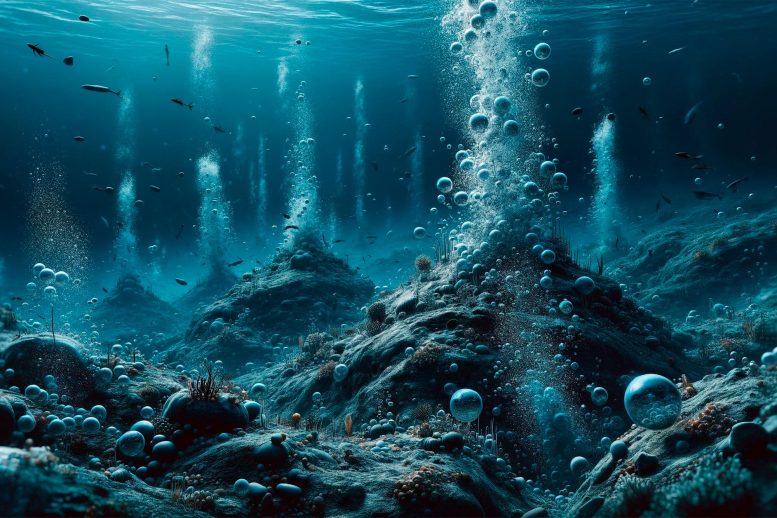
New research reveals that fire-ice, or frozen methane which is trapped as a solid under our oceans, is at risk of melting due to climate change, potentially releasing large amounts of methane into the atmosphere. Using advanced seismic imaging, the team found that dissociated methane can migrate significant distances, challenging previous assumptions about its stability.
Research indicates that oceanic fire-ice, or frozen methane, is vulnerable to melting from climate change, posing a significant threat of methane release into the atmosphere.
An international team of researchers led by Newcastle University found that as frozen methane and ice melts, methane — a potent greenhouse gas — is released and moves from the deepest parts of the continental slope to the edge of the underwater shelf. They even discovered a pocket that had moved 25 miles (40 kilometers).
Publishing in the journal Nature Geoscience, the researchers say this means that much more methane could potentially be vulnerable and released into the atmosphere as a result of climate warming.
Methane Hydrate: A Hidden Climate Threat
Methane hydrate, also known as fire-ice, is an ice-like structure found buried in the ocean floor that contains methane. Vast amounts of methane are stored as marine methane under oceans. It thaws when the oceans warm, releasing methane into oceans and the atmosphere — known as dissociated methane — contributing to global warming.
The scientists used advanced three-dimensional seismic imaging techniques to examine the portion of the hydrate that dissociated during climatic warming off the coast of Mauritania in Northwest Africa. They identified a specific case where dissociated methane migrated over 40 kilometers and was released through a field of underwater depressions, known as pockmarks, during past warm periods.
Newcastle University researchers have found that frozen methane trapped under our oceans, is vulnerable to melting due to climate change and could be released into the sea. Credit: Newcastle University
Discovery and Implications
Lead author, Professor Richard Davies, Pro-Vice-Chancellor, Global and Sustainability, Newcastle University, said: “It was a Covid lockdown discovery, I revisited imaging of strata just under the modern seafloor offshore of Mauritania and pretty much stumbled over 23 pockmarks. Our work shows they formed because methane released from hydrate, from the deepest parts of the continental slope vented into the ocean. Scientists had previously thought this hydrate was not vulnerable to climatic warming, but we have shown that some of it is.”
Researchers have previously studied how changes in bottom water temperature near continental margins can affect the release of methane from hydrates. However, these studies mainly focused on areas where only a small portion of global methane hydrates are located. This is one of only a small number that investigates the release of methane from the base of the hydrate stability zone, which is deeper underwater. The results show that methane released from the hydrate stability zone traveled a significant distance toward land.
Broader Research Perspectives and Future Plans
Professor Dr. Christian Berndt, Head of the Research Unit Marine Geodynamics, GEOMAR, in Kiel, Germany, added:
“This is an important discovery. So far, research efforts focused on the shallowest parts of the hydrate stability zone, because we thought that only this portion is sensitive to climate variations.
“The new data clearly show that far larger volumes of methane may be liberated from marine hydrates and we really have to get to the bottom of this to understand better the role of hydrates in the climate system.”
Methane is the second most abundant anthropogenic greenhouse gas after carbon dioxide (CO2). Figures from the United States Environmental Protection Agency show that methane accounts for about 16% of global greenhouse gas emissions.
The study results can play a key role in helping to predict and address the impact of methane on our changing climate.
The team plans to continue to search for evidence of methane vents along the margin and try to predict where massive methane seeps are likely to occur as we warm the planet. The researchers are now planning a scientific cruise to drill into the pockmarks and see if they can more closely tie them to past climatic warming events.
Reference: “Long-distance migration and venting of methane from the base of the hydrate stability zone” by Richard J. Davies, Jinxiu Yang, Mark T. Ireland, Christian Berndt, Miguel Ángel Morales Maqueda and Mads Huuse, 6 December 2023, Nature Geoscience.
DOI: 10.1038/s41561-023-01333-w









“Figures from the United States Environmental Protection Agency show that methane accounts for about 16% of global greenhouse gas emissions.”
As measured by weight or molecular fraction?
The methane deposits that were studied (~450-700m) were below the typical top of the thermocline (~200m), which is the bottom of the mixed zone. If it is below the mixed zone, then how is global warming triggering the decomposition of the methane hydrates? Are the authors sure that these ‘blowouts’ didn’t occur during a cold time when sea level was much lower, thus reducing pressure and lowering the bottom of the mixed zone (~120m) and reducing stability?
We have known about the methane hydrates melting on the continental shelves since at least 2014. What is surprising here is the depth. If they are melting 450 to 700 meters below the surface, that means that one of the two things that keep the methane bound to the water ice (pressure and temperature) has changed.
According to Bing Chat, “Methane hydrates, also known as clathrates, were first discovered in the early 20th century. However, it wasn’t until the 1960s that they were identified as a potential energy resource.”
Scientists Reveal the REAL Cause Of ‘Global Warming’ And Liberals Are Losing Their Minds
In an article summarizing the scientists’ findings, which were originally published this week in the journal Nature…
A new study produced by a University of Wisconsin-Madison geoscientist and Northwestern astrophysicist provides an interesting explanation of the fluctuations of the earth’s temperatures that global warming liberals that blame mankind are sure to be furious about.
C.E. Dyer at The Federalist Papers Project reports that the study found that small changes in the Earth’s orbit can change the amount of solar radiation that the planet receives, which could account for the changes. As the study noted, “where and how much solar radiation a planet gets is a key driver of climate.”
The Daily Wire reported:
While the theory that solar radiation is the most significant factor determining global temperatures is anything but new, the team of scientists have reportedly tied the phenomenon to planetary orbits in a more concrete manner than previous studies.
In an article summarizing the scientists’ findings, which were originally published this week in the journal Nature, the University of Wisconsin-Madison notes that the study “provides the first hard proof for what scientists call the ‘chaotic solar system,’ a theory proposed in 1989 to account for small variations in the present conditions of the solar system.” Those variations over millions of years “produce big changes in our planet’s climate.”
Not only does the new discovery promise to provide a better understanding of “the mechanics of the solar system,” but also “a better understanding of the link between orbital variations and climate change over geologic time scales.”
While this huge discovery should be welcome to everyone, those in the business of making money off of the man-made climate change hoax, as well as gaining power and control from it, won’t be pleased.
Those who claim to care about the environment, if they truly do, should be very interested and encouraged by developments like this. But as we all know, the vast majority won’t be, because this development hurts their radical agenda.
This is, however, a fascinating development that adds to the growing evidence, including common sense, that shows how absurd it is to cripple our economy and follow the whims of the man-made climate change snake-oil salesmen.
Between this development and reports that the polar bears are thriving, hoaxers like Al Gore are really having a rough time.
Look, it’s just weather- get over it and move on.
The first question that comes to mind is – where does it come from?
(Or, how did it end up in the bottom of the sea.)
Bacterial decomposition of dead plankton in a low-oxygen environment.